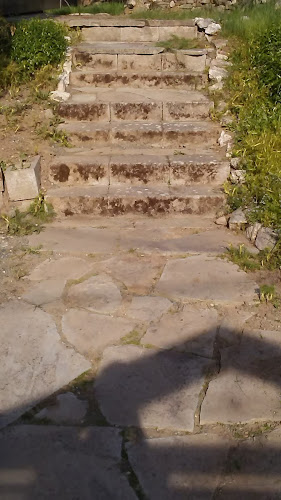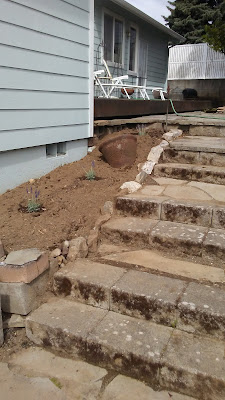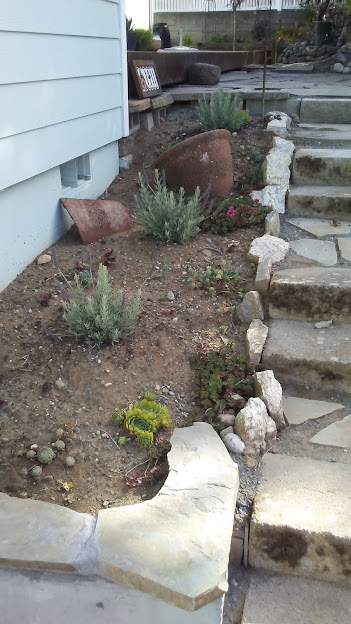Gardening requires lots of water – most of it in the form of perspiration.
~Lou Erickson
There is a set of stairs at the back of the house
dividing the sloped south facing yard into two terraced levels. This is how the
beds on both sides of the stairs looked in April when we moved in. The post
today is only about the left side, which is up against the foundation of the
house and south facing, so it is hot and dry.

My first thoughts were that lavender and sedums would
be perfect plants for this area. Once established (after next year) they wouldn’t
require a lot of watering as both thrive in hot dryish areas with all day sun, and they would provide food for bees, hummingbirds and other pollinators.

The only plants in that bed, aside from weeds, was
a vinca tangled up with a Euonymus. The bed is just shy of 3 feet wide and 10
feet long.
Vinca is a vining, far reaching ground cover that
is very ineffective at smothering out weeds and it will have to be constantly
cut back if it isn’t to interfere with the walkway. It’s out.
The Euonymus is, to my taste, an uninteresting
shrub that can reach out 4-6 feet wide and even taller. In this location it too
would have to be pruned annually once it reached its mature size. And it would
block the view of the garden I planned to create on the other side of the walk.
Out it goes too.
The bed was bordered with rocks on the stair edge,
presumably to stop the dirt from spilling out onto the stairs. As you can see
over time the lower rocks became buried and weren’t doing the job. Lastly, there was a makeshift retaining wall made of mis-matched blocks at the bottom of the bed which had collapsed. Sorry, I didn't get a good photo of that.

All cleared away, now I have a blank slate to work with. First in goes 3 lavenders. “Goodwin Creek” to be specific. I have grown this one before and it is a favorite of mine. I love the indented leaf shape and it puts up long willowy wands of blooms which create lovely movement in the breeze. It also had a longer bloom time in my previous garden than other lavenders. It is a lovely variety.
Along with the lavender, I added a broken portion of a Mexican pottery pot. I like using broken pots as a little interest, or whole pots turned on their side and angled just so. A little eye candy if you will.

After the lavenders are placed as the “bones” of the
space, I filled in with sedums of many varieties from trailing types to hen’s
and chicks types, all of which came with me from my previous garden. Sedums are
incredibly easy to propagate. They will spread and fill in quickly.
As for the lost rocks edging the lowest steps, I
pulled them up and re positioned them. I don’t really like rocks used that way
but for now they will stay.

If all that isn’t exciting enough, now the icing on
the cake happens! This is where my better half comes into his own. He is so
creative and talented when it comes to hardscaping our garden spaces. He set about
making a beautiful retaining wall to support the end of this bed. He used concrete
blocks and capped them with flat stones. The blocks and stones had been left, stashed
and buried in different places in this yard, by past owners.

First, he carved out the shape, and poured a footing
in concrete.

Then cemented together blocks.

Then he ‘faced’ the blocks with a rough smear of mortar.
He adds color powder to the mortar to give an aged look to his stucco finish. New concrete dries bright whitish and isn’t particularly lovely. The new brightness can be distracting in the garden, I think. Concrete does darken over time but it takes years. He ‘ages’ it by darkening it with coloring agents so the new wall looks like it’s been there for a long time and it blends better in the garden. I love the rough look of a stucco finish. It transports me to Tuscany or south of the border.

Then he capped it all off with some slate or what
ever this stone is. There were several pieces of this stone laying around,
apparently left-overs from the construction of the patio some years ago. I am
so glad to have them as they are just perfect to finish this wall.

So… what do you think? Coming along nicely, I
think. In a year or two you won’t see much, if any, soil after these plants
fill in. Covered soil means less weeds. Win Win.
Cheers!
In Bloom in my Garden Today: Rose,
Sedum, Agastache, Geum, Fuchsia, Salvia, Verbena, Gladiolus, Mullen, Thyme,
Oregano, Calendula, Yarrow, Dianthus, Germander, Cuphea,
Author’s photos





